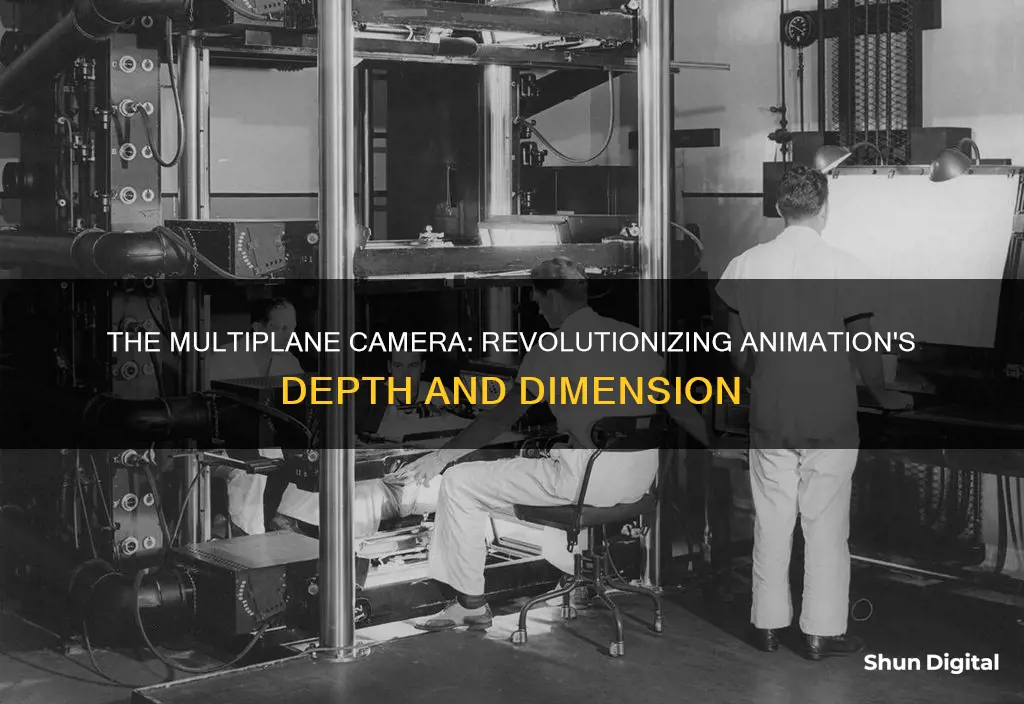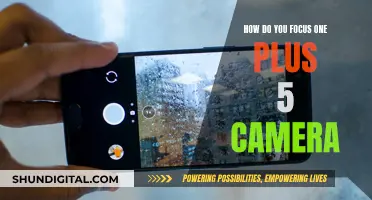
Animation has been around for nearly 100 years, and as the industry has grown, it has had to change. Animators have always faced the challenge of creating the illusion of depth in their work, as they are trying to represent 3-dimensional objects with only 2 dimensions. The multiplane camera was invented to solve this problem and create more dynamic animations. The multiplane camera, invented by William Garity in 1937 for Walt Disney Studios, allowed animators to film multiple planes at once, creating an effect known as parallax, where an object's position seems to differ depending on the viewing position. This camera revolutionised traditional animation in the 1930s and beyond, adding depth, dimension and dynamism to films, making them more appealing and engaging for audiences.
| Characteristics | Values |
|---|---|
| Inventors | William Garity, Walt Disney |
| Date invented | 1937 |
| Purpose | To create the illusion of depth in animated films |
| Function | Filmed multiple planes at once, with up to seven layers of cels mounted on movable metal frames |
| Benefits | Added depth, dimension, and dynamism to films; enabled realistic tracking shots, rotating images, and special effects |
| Limitations | Expensive, bulky, time-consuming, required a lot of manpower, precision, and coordination |
| Impact | Revolutionized traditional animation, influenced other forms of animation, and inspired future animators and filmmakers |
What You'll Learn

To create depth in animation
Animation has been around for nearly 100 years, and the industry has evolved significantly during this time. A fundamental challenge in animation is creating a sense of depth when representing 3D objects on a 2D screen. Early animators had to hand-draw each frame and record images with a physical camera, with no fancy software to rely on.
The multiplane camera was invented to address this issue and create depth in animation. The earliest technique used to create depth was in the oldest surviving animated film, "The Adventures of Prince Achmed" (1926) by German filmmaker Lotte Reiniger. Reiniger and her team physically created individual layers by cutting out sheets of cardboard and lead, then moving them around while filming. This created footage with layers that could be adjusted independently, resulting in dynamic foreground and background images.
Walt Disney further developed the multiplane camera, inspired by Reiniger's work. Disney wanted to increase the eye value of the paintings by achieving a soft-focus effect on the backgrounds, illuminating the various levels of each scene individually, and separating the background from the foreground. He invented a multiplane camera that used up to seven layers of cels, each mounted on a movable metal frame, and a vertical camera that could be raised or lowered to adjust the focus and distance. This allowed for the creation of realistic tracking shots, rotating images, and special effects such as flickering lights and running water.
The multiplane camera revolutionized traditional animation by adding depth, dimension, and dynamism to films, making them more appealing and engaging for audiences. Some notable examples of its use include the opening scene of "Snow White and the Seven Dwarfs" (1937), the flight over London in "Peter Pan" (1953), and the forest fire in "Bambi" (1942). The multiplane camera also influenced other forms of animation, such as stop-motion, CGI, and video games.
Mastering Park Camera Mode: Understanding the Boxes
You may want to see also

To improve upon the limitations of early animation
Animation has been around for nearly a century, and as the industry has grown, animators have had to innovate to overcome various limitations. One of the fundamental challenges in animation is creating depth. The issue with animation (and film in general) is that it attempts to represent three-dimensional objects on a two-dimensional screen, resulting in a loss of depth.
Early animators had to rely on their ingenuity to tackle this problem. They had to hand-draw each frame and record it with a physical camera, without the sophisticated software available today. One technique used to create depth was to draw numerous images with slight variations, but this approach was impractical for certain types of shots.
To address these limitations, animators sought to create multiple layers that could move independently, as this would better simulate depth. The earliest known example of this technique is seen in the 1926 film "The Adventures of Prince Achmed" by German filmmaker Lotte Reiniger. Reiniger and her team physically created individual layers by cutting out sheets of cardboard and lead, which they moved around while filming. While this style of animation was innovative, it had limitations in terms of detail and colour vibrancy.
Animators began experimenting with new methods to enhance depth, and in 1937, Disney released "Snow White and the Seven Dwarfs," revolutionising animation. Disney introduced the multiplane camera, which allowed them to film multiple planes simultaneously. This camera had several layers of transparent sheets, each with a single element of the scene painted on it, creating depth as the layers moved at different speeds.
Disney's multiplane camera, designed by William Garity, was the most advanced version of its time. It featured seven layers of artwork, a vertical setup, and a movable camera, enabling more sophisticated uses than its predecessors. This camera played a pivotal role in Disney's animation process, being used in films such as "Pinocchio," "Cinderella," "Bambi," and "The Jungle Book."
Refurbished Camera Battery: Good Idea or Not?
You may want to see also

To achieve a soft-focus effect on backgrounds
The multiplane camera was invented in 1937 by William Garity for Walt Disney Studios. It was an incredible piece of technology that helped create the illusion of depth in animated motion pictures. Disney wanted to increase the eye value of the many paintings that made up a picture by achieving a soft-focus effect on the backgrounds. This was done by illuminating the various levels of each scene individually and separating the background from the foreground, thus keeping background objects to their proper relative size.
The multiplane camera was an advanced version of early animation techniques that used multiple layers of glass or cardboard cutouts to create depth. Disney's multiplane camera used up to seven layers of artwork (painted in oils on glass) shot under a vertical and moveable camera set for successive frame Technicolor. This allowed for more sophisticated uses than previous multiplane cameras, such as the one created by ex-Disney animator Ub Iwerks.
Disney's multiplane camera resembled a printing press and stood eleven feet tall and six feet square. It was made with almost micrometre precision, allowing for accurate photographing of foreground and background cels, even when the first was held firmly in place two feet from the lens and the lowest rested in its frame nine feet away. When the script called for the camera to "truck up" for a close-up, the lens remained stationary while the various cels were moved upward. This allowed houses, trees, the moon, and any other background features to retain their relative sizes.
To operate the camera, a technician would take their place at each level of the camera, adjusting the cel, lowering or raising it, and top-lighting or back-lighting their part of the scene as required. By moving all cels except those with characters painted on them across the camera at the same speed, the illusion of distance was created. This technique also allowed for new types of special effects in animated films, such as moving water and flickering lights.
Unlocking Kik Camera: Modding for Creative Freedom
You may want to see also

To illuminate individual levels of a scene
The multiplane camera was invented in 1937 by William Garity for Walt Disney Studios. It was an innovative piece of technology that helped create the illusion of depth in animated films. Disney wanted to increase the eye value of the many paintings that made up a picture by achieving a soft-focus effect on the backgrounds, illuminating the various levels of each scene individually, and separating the background from the foreground.
The multiplane camera was made up of four vertical steel posts, each carrying a rack along which up to eight carriages could be shifted both horizontally and vertically. On each carriage was a frame containing a sheet of celluloid, on which part of the action or background was painted. The camera stood eleven feet tall and was six feet square. It allowed for the accurate photographing of foreground and background cels, even when the first was held just two feet from the lens and the lowest nine feet away.
When everything was ready for action, an operator took their place at each level of the camera, adjusting the cel, lowering or raising it, and top-lighting or back-lighting their part of the scene as required. By moving all cels except those with characters painted on them across the camera at the same speed, the illusion of distance was created.
The multiplane camera was a significant development in the history of animation, allowing animators to create a realistic sense of three-dimensional depth in a cartoon setting. It also enabled new types of special effects, such as moving water and flickering lights.
Exploring the Toggle Feature in Camera Raw
You may want to see also

To make Disney's animations more realistic and immersive
Animation has been around for nearly a century, but it has evolved significantly over the years. One of the biggest challenges for early animators was creating a sense of depth in their 2D images. This was achieved through a technique called parallax, where objects in the distance appear to move more slowly than those closer to the camera. However, creating this effect was time-consuming and impractical, especially for certain types of shots.
The multiplane camera was invented to address this issue and create more realistic and immersive animations. The camera allowed animators to film multiple planes at once, creating the illusion of depth and making objects appear three-dimensional. Disney's multiplane camera, invented in 1937, was particularly innovative and influential. It consisted of multiple layers of transparent sheets, or cels, that could be moved independently to create depth and parallax. The camera also had a vertical setup, which allowed for a greater range of shots than previous horizontal designs.
Disney's camera revolutionised animation, adding depth, dimension, and dynamism to films. It enabled animators to create realistic tracking shots, rotating images, and special effects such as flickering lights and running water. The most famous example of the multiplane camera in action is in the opening scene of "Snow White and the Seven Dwarfs" (1937), where it creates a sense of movement and depth as the camera pans through the forest. Other notable uses include the flight over London in "Peter Pan" (1953) and the forest fire in "Bambi" (1942).
The multiplane camera was a significant step forward in the history of animation, inspiring future innovations in stop-motion, CGI, and video games. While it has since been replaced by digital animation techniques, it remains a testament to the creativity and ambition of early animators like Disney.
Mounting a Battery Plate: A Guide for Cameramen
You may want to see also
Frequently asked questions
The multiplane camera was made to create the illusion of depth in animated films.
The multiplane camera films through several layers of drawings, with the lens focusing on any one of the layers to create a dynamic final product.
The multiplane camera consists of multiple vertical layers of transparent sheets or panes of glass, with each layer containing a different element of the scene.
The multiplane camera was invented by William Garity for Walt Disney Studios in 1937.
The multiplane camera was first used in the 1937 short film "The Old Mill". It was then used in the first full-length animated film, "Snow White and the Seven Dwarfs". Other films that used the multiplane camera include "Pinocchio", "Cinderella", "Bambi", "Alice in Wonderland", and "The Little Mermaid".







